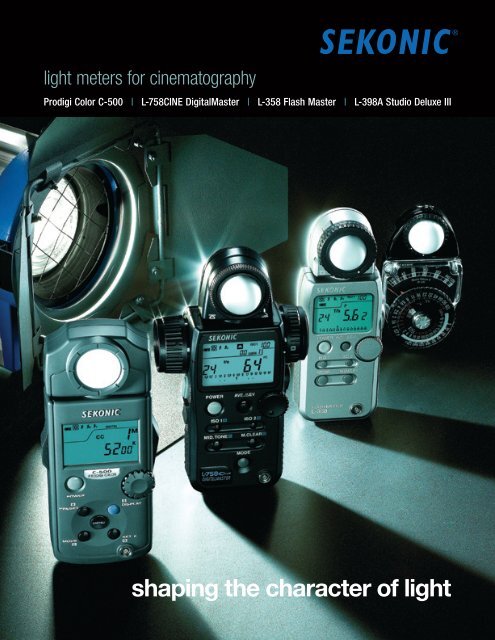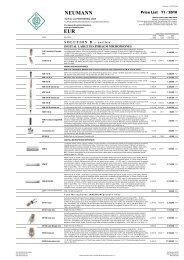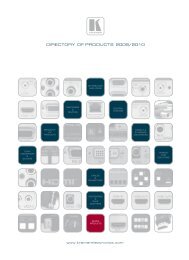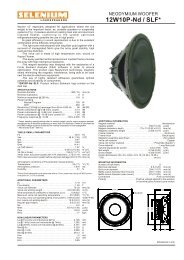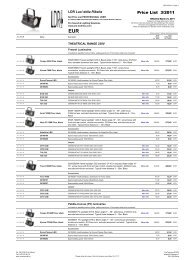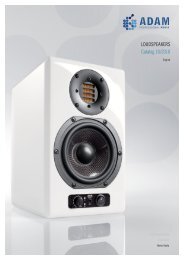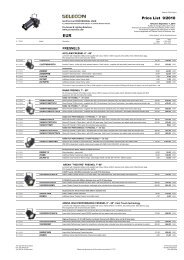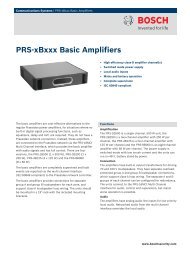light meters for cinematography - Sekonic
light meters for cinematography - Sekonic
light meters for cinematography - Sekonic
You also want an ePaper? Increase the reach of your titles
YUMPU automatically turns print PDFs into web optimized ePapers that Google loves.
<strong>light</strong> <strong>meters</strong> <strong>for</strong> <strong>cinematography</strong><br />
Prodigi Color C-500 | L-758CINE DigitalMaster | L-358 Flash Master | L-398A Studio Deluxe III<br />
shaping the character of <strong>light</strong>
Cinematic <strong>light</strong>ing is craft on a schedule. It has two masters: The director and the clock.<br />
Good <strong>light</strong>ing is more than just correct exposure. And correct exposure is more than just the<br />
right camera settings. Properly shaped <strong>light</strong> is vital to storytelling. It directs the viewer and<br />
sets the mood. And correct exposure is critical to achieving full tonality and proper color<br />
saturation. Both have to be done right and done on time. That is why <strong>Sekonic</strong> is becoming<br />
the cinematographer’s meter of choice.<br />
Light is measured in two ways<br />
Incident Light Metering<br />
Incident metering tells you about the <strong>light</strong> you are controlling. It’s hemisphere<br />
receptor is designed to integrate all of the illumination that falls on it, and the<br />
subject, including the key <strong>light</strong>, line <strong>light</strong>, hair <strong>light</strong>, eye <strong>light</strong>s, etc. Besides taking<br />
nearly foolproof exposure readings, incident <strong>light</strong> <strong>meters</strong> enable you to set up and<br />
<strong>light</strong> a scene be<strong>for</strong>e the principal talent arrives. They also allow “walking the set”<br />
to measure the evenness of the illumination. The <strong>Sekonic</strong> L-758CINE and L-358<br />
offer the convenience of a retractable Lumisphere. Retract the Lumisphere to read<br />
individual <strong>light</strong> sources to adjust them to the desired ratio. Extend it to take an<br />
exposure reading at the subject position.<br />
Reflected Light Spot Metering<br />
Reflected <strong>light</strong> metering tells you about the scene and subject. Different from<br />
incident <strong>light</strong> metering that produces readings only <strong>for</strong> the middle of the exposure<br />
range, reflected <strong>light</strong> spot metering can show you where the edges are. To get the<br />
most out of a spot meter, use it to measure the brightest and darkest areas you<br />
want in the scene to determine the scene brightness range. This will help you <strong>light</strong><br />
the scene to fit your digital camera or film. The L-758CINE’s analog scale, 9-reading<br />
memory and averaging functions enable quick measurement of the brightness<br />
range and producing an averaged center point. Then a simple skin tone or gray card<br />
reading at the talent position will tell you where to start. Spot metering with<br />
this precision requires that you know the dynamic range of your DV camera or film.<br />
The L-758CINE’s Latitude Display can be programmed to mirror the dynamic range<br />
of your digital camera or film.<br />
3 SEKONIC.com
! Key HigHligHts<br />
Light Color/ Brightness Display<br />
»<br />
»<br />
»<br />
»<br />
Kelvin color temperature<br />
Lens filtration in LB/CC filter numbers<br />
Light source filtration in Index numbers<br />
Incident readings in Foot Candles or Lux<br />
RELAtIvE SPECtRuM<br />
<strong>Sekonic</strong> Prodigi Color C-500<br />
Cat# 401-500 (C-500) | Cat# 401-501 (C-500R)<br />
The PRODIGI COLOR C-500 is the first photographic color meter that measures<br />
and displays color temperature and compensation values in LB/CC index or filter<br />
numbers <strong>for</strong> both DV cameras and film. Working on location with today’s mix of<br />
tungsten, halide, vapor and fluorescent <strong>light</strong>s can be challenging. The C-500 gives<br />
you the control you need to balance sources and accurately reproduce color tones<br />
from set to set.<br />
Digital and film compatible<br />
The PRODIGI COLOR C-500 and C-500R measure and display color temperature<br />
and compensation values in LB/CC index or filter numbers <strong>for</strong> both digital and<br />
film cameras. In Digital Mode, the color temperature and compensation readings<br />
are based on human visual response. In Film mode, readings are based on the<br />
color characteristics of traditional photographic film. By engineering the spectral<br />
characteristics of both systems into a single meter, <strong>Sekonic</strong> designers have given<br />
you greater control over <strong>light</strong>ing and color reproduction than ever be<strong>for</strong>e, regardless<br />
of your medium.<br />
The Rd sensor set responds to Digital Color Sensitivity<br />
WAvE LENgth (NM)<br />
RELAtIvE SPECtRuM<br />
Color control<br />
<strong>for</strong> today’s DV<br />
cameras and film<br />
The Rf sensor set responds to Film Color Sensitivity<br />
WAvE LENgth (NM)<br />
4 SEKONIC.com
One press display button<br />
<strong>for</strong> easy readout of all important in<strong>for</strong>mation<br />
Color Temperature Display (in Kelvin)<br />
The color temperature is displayed <strong>for</strong> human visual response in Digital Mode or<br />
the spectral response <strong>for</strong> photographic color film in Film Mode.<br />
LB/CC Index Display<br />
The LB (Light Balancing) in MK -1 (Per Mega Kelvin equivalent to Mired) and<br />
CC (Color Compensation) Index correspond to <strong>light</strong> source filtration systems.<br />
This simplifies the selection of amber (CTO) or blue (CTB) filtration as well as the<br />
amount of magenta or green (CC) filtration needed to balance the color of the<br />
<strong>light</strong>s you are using.<br />
LB/CC Filter Number Display<br />
Used primarily <strong>for</strong> film applications, the amount of lens filtration needed is directly<br />
indicated in both LB (Light Balancing) and CC (Color Compensation) filter values.<br />
The display can be adjusted to read out in KODAK Wratten, LEE or FUJIFILM filter<br />
systems in the custom setting MENU.<br />
Illuminance Measurement<br />
The brightness of continuous <strong>light</strong> sources is displayed in foot candles (FC) or LUX<br />
(lx). Illuminance measurement is especially useful <strong>for</strong> <strong>cinematography</strong>, videography,<br />
theatrical and other applications that require precise control of <strong>light</strong> source brightness.<br />
Preset White Balance / Color Compensation Function<br />
Nineteen presets enable adjusting display values to compensate <strong>for</strong> differences in<br />
film types, <strong>light</strong> sources, digital sensors, or personal preference. An eight-character<br />
readout on the display allows creating custom naming <strong>for</strong> easy identification of the<br />
compensation value.<br />
Memory (Δ) Function<br />
A simple way to observe differences in <strong>light</strong> source color or brightness is with the<br />
C-500’s memory function. Simply take a reference reading and press the memory<br />
(Δ) button. Then press the measuring button and measure any other <strong>light</strong> source to<br />
see the difference in color (Kelvin or filtration) or brightness (foot-candle or Lux).<br />
Custom Settings<br />
. Shutter speed steps (Full, 1/3 step or 1/2 step)<br />
. Target color temperature increments (100K, or 10MK<br />
−1 Step)<br />
−1 −1 −1 . LB index display step (1MK , 1daMK step, w/o decimal point, 1daMK step<br />
with decimal point)<br />
. LB filter number display (Kodak/LEE or Fujifilm)<br />
. Automatic power off setting (5, 10, or 20 minutes, or no turn off)<br />
. Illuminance measurement mode (No display, either FC or lx, both FC and lx)<br />
Color Temperature<br />
LB/CC Index<br />
LB/CC Filter Number<br />
Illuminance Measurement<br />
Preset White Balance / Color Compensation<br />
Memory (Δ) Function<br />
Color Difference<br />
5 SEKONIC.com<br />
_
! Key HigHligHts<br />
Cinematography Display<br />
»<br />
»<br />
»<br />
Full range of Cine speeds (1~1000 fps)<br />
Shutter angles from 1~270 degrees<br />
Aperture and EV readout<br />
Light measurement Display<br />
»<br />
Incident readings in Foot Candles/Lux<br />
» Reflected <strong>light</strong> readings in Foot Lamberts<br />
and Cd/m²<br />
<strong>Sekonic</strong> L-758CINE DigitalMaster<br />
Cat# 401-760<br />
The <strong>Sekonic</strong> L-758CINE offers the latest digital video camera features and settings.<br />
It has the most extensive range of frames per second and shutter angle settings<br />
making it the ultimate <strong>light</strong>-measuring tool <strong>for</strong> cinematographers and videographers.<br />
Full in<strong>for</strong>mation Spot Viewfinder<br />
The 1-degree spot meter has a broad reading range<br />
from EV 1 to EV 24.4 (0.07 to 190,000 FL). Its large,<br />
bright viewfinder with diopter correction and full-<br />
in<strong>for</strong>mation data display give you everything you<br />
need to make the right exposure decisions without<br />
having to take your eye from the eyepiece.<br />
Memory Mode and Latitude Display<br />
Up to nine readings can be memorized in incident or spot metering modes. An<br />
indicator appears on the analog display each time a measurement is memorized and<br />
the total number of memorized measurements appears numerically on the screen.<br />
Memorized readings are retained when switching between reading modes. This<br />
provides a fast and simple way of retaining and analyzing shadow, mid tone and<br />
high<strong>light</strong> exposure readings. Digital readings can be recalled and/or cleared at any<br />
time <strong>for</strong> precise exposure control.<br />
The dynamic range of your digital camera or film can be programmed into the<br />
L-758CINE to create a Latitude Display that mirrors the range of your system.<br />
This important guide will let you know when readings fit within the latitude of your<br />
system and when they are outside the range.<br />
Full-featured<br />
exposure analyzer<br />
<strong>for</strong> today’s<br />
cinematographer<br />
Camera Dynamic Range<br />
Shadow Mid-tone High<strong>light</strong><br />
6 SEKONIC.com
Contrast Function<br />
The contrast function switches the data displays to a simple, direct EV readout to<br />
enable measuring scene brightness and create <strong>light</strong>ing ratios faster than ever be<strong>for</strong>e.<br />
Incident Light Metering<br />
. Measure the key <strong>light</strong> and press the AVE/ΔEV button. Press the measuring<br />
button to read the fill <strong>light</strong> and the digital display instantly switches to EV to show<br />
the brightness difference with tenth-stop accuracy.<br />
Reflected Light Spot Metering<br />
. Establishing scene brightness has never been this simple. Spot meter a high<strong>light</strong><br />
area and press the AVE/ΔEV button. Then measure the shadows to instantly see<br />
the difference in scene brightness without ever taking your eye from the viewfinder.<br />
. Press the memory button to compute an averaged mid-tone and display all three<br />
readings on the dynamic range line of the L-758 CINE’s analog display. This quick and<br />
easy method gives you all the in<strong>for</strong>mation you need to make every exposure decision.<br />
Dual ISO Settings<br />
Dual ISO buttons enable quick adjustment of exposure when working with two ISO<br />
speeds and making adjustments <strong>for</strong> filter compensation or calling up one of seven<br />
commonly used Wratten filter factors.<br />
All-Weather Design<br />
All buttons, switches and compartments are sealed and the meter housing has been<br />
designed to endure rugged outdoor conditions. Ideal <strong>for</strong> location shooting, in rainy<br />
or humid environments.<br />
Cine/<strong>light</strong>ing Displays <strong>for</strong> L-758CINE<br />
1 FC Appears when Foot Candle is selected<br />
2 LUX Appears when Lux is selected<br />
3 FL Appears when Foot Lambert is selected<br />
4 cd/m² Appears when cd/m² is selected<br />
5 f/s Shutter speed display <strong>for</strong> frames per second (f/s)<br />
6 Ang Appears when shutter angle is set to a value other than 180 degrees<br />
High<strong>light</strong> Spot Viewfinder<br />
Averaged Mid-tone<br />
6<br />
5<br />
f/number<br />
Shadow Spot Viewfinder<br />
Brightness Difference<br />
1 2<br />
7 SEKONIC.com<br />
3<br />
4
! Key HigHligHts<br />
Cinematography Display<br />
»<br />
»<br />
Full range of Cine speeds (2~360 fps)<br />
Aperture and EV readout<br />
<strong>Sekonic</strong> L-358 Flash Master<br />
Cat# 401-358<br />
The versatility of today’s cameras is expanding at an amazing rate. You can use a<br />
digital video camera to capture still frames <strong>for</strong> printing and digital SLR camera to<br />
record moving images. Whether you are a cinematographer, a still photographer or<br />
involved in any facet of image capture, the <strong>Sekonic</strong> L-358 is the perfect meter <strong>for</strong> you.<br />
Ambient Light Metering<br />
Take readings from f/1 to f/90.0 with 1/10th stop accuracy at frame rates from<br />
2 to 360fps. L-358 displays exposure both digitally and on an analog scale <strong>for</strong> easy<br />
readout. Selectable DIP switches enable adjusting the aperture readout <strong>for</strong> full, half,<br />
and third-stop increments to mirror the settings of your camera. You can change<br />
exposure settings after taking readings and the meter will automatically compensate<br />
to maintain the proper exposure. And the extended sensitivity range, EV−2 to 22.9<br />
<strong>for</strong> ISO 100, allows taking exposure measurements in virtually any kind of <strong>light</strong>.<br />
Contrast Function<br />
Advanced features<br />
in an easy-to-use,<br />
rugged design<br />
Setting up <strong>light</strong>ing ratios or checking the evenness of a background or scene is<br />
push-button simple. Take a reading of the key or reference <strong>light</strong> and press the<br />
AVE/ΔEV button to create a standard. Then press the measuring button to display<br />
the brightness difference between the standard and new reading.<br />
Key Light Fill Light<br />
8 SEKONIC.com
Memory Mode and Average Function<br />
Up to nine readings can be memorized. An indicator appears on the analog display<br />
each time a measurement is memorized and the total number of memorized<br />
measurements appears numerically on the screen. Pressing the AVE/ΔEV button<br />
displays the average of values in memory.<br />
Exposure and Calibration Compensation<br />
Exposure compensation of up to +/−9.9 EV can be easily set to filter compensation.<br />
Calibration compensation can be used to tune the L-358 to film or digital camera<br />
sensors or matching the L-358 to other handheld <strong>meters</strong>.<br />
All-Weather Design<br />
All buttons, switches and compartments are sealed and the meter housing has been<br />
designed to endure rugged outdoor conditions. Ideal <strong>for</strong> location shooting in rainy<br />
or humid environments.<br />
Additional Features<br />
. Aperture and shutter priority exposure reading <strong>for</strong> still cameras<br />
. Flash measurement in Cordless, Corded or Radio triggered flash with<br />
optional module<br />
. Flash analyzing mode <strong>for</strong> fine adjustment of flash-ambient <strong>light</strong> balance<br />
. Accumulated flash measurement<br />
. Standard Reflected <strong>light</strong> attachment with 54° reading<br />
Optional Spot Viewfinders<br />
The L-358 accepts optional spot finder attachments that<br />
extend the versatility of the meter with a choice of 1°, 5° or 10°<br />
spot measurements, which easily attach to the meter. Each<br />
spot finder features parallax-free swiveling eye-piece<br />
<strong>for</strong> precise spot metering.<br />
Background Average Key Light<br />
2 Stop Filter Correction<br />
All-Weather Design<br />
9 SEKONIC.com
! Key HigHligHts<br />
Cinematography Display<br />
»<br />
»<br />
Most used Cine speeds (8 through 128 fps)<br />
Aperture and EV readout<br />
Light Measurement Display<br />
»<br />
Incident readings in Foot Candles<br />
<strong>Sekonic</strong> L-398A Studio Deluxe III<br />
Cat# 401-399<br />
The classic photo meter that traces its roots to the famous Norwood Director, the<br />
<strong>Sekonic</strong> 398A has become a favorite with cinematographers the world over. A pure<br />
analog experience, the meter needle and exposure dial system gives you all reading<br />
combinations at a single glance. And because it uses an amorphous photocell that<br />
generates its own power, there is no need <strong>for</strong> a battery.<br />
Features<br />
. Instant reading of full range of aperture/shutter combinations<br />
. Amorphous photosensor eliminates need <strong>for</strong> batteries<br />
. Continuous reading plus needle lock <strong>for</strong> easy and accurate readings<br />
. Swivel Head to position incident dome and maintain full view of display<br />
. Lumidisc <strong>for</strong> adjusting illumination contrast and measuring illumination intensity<br />
. Lumigrid <strong>for</strong> measuring reflected <strong>light</strong><br />
. Memory pointer retains prior reading<br />
. Supplied with Lumisphere, Lumidisc, Lumigrid, High-slide, case and neck cord.<br />
Set of 11 direct reading slides sold separately<br />
L-398A Specifications<br />
Classic analog<br />
<strong>light</strong> meter <strong>for</strong><br />
battery-free ambient<br />
<strong>light</strong> readings<br />
Type Hand-held exposure meter <strong>for</strong> measuring <strong>for</strong> ambient <strong>light</strong><br />
Light Receptor Element Amorphous silicon photocell<br />
Light Receiving Method Lumisphere (<strong>for</strong> incident), Lumigrid (<strong>for</strong> reflected)<br />
Film Speed ISO 6 to 12000<br />
f/stop Range f/0.7 to f/128<br />
Shutter Speed 60 to 1/8000 sec<br />
Movie Scale 8 to 128 fps<br />
Dimensions 2.3w × 4.4h × 1.3d in (58w × 112h × 34d mm)<br />
Weight 6.7 oz (190 g)<br />
10 SEKONIC.com
L758CINE and L-358 Specifications<br />
<strong>Sekonic</strong> Meter L-758CINE DigitalMaster L-358 Flash Master<br />
Type Hand-held exposure meter <strong>for</strong> measuring<br />
Hand-held exposure meter <strong>for</strong> measuring<br />
ambient and flash <strong>light</strong><br />
ambient and flash <strong>light</strong><br />
Light Receptor Element 2-Silicon photo diodes (incident and reflected) Silicon photo diode<br />
Light Receiving Incident Light Rotating Head 90° to the right, 180° to the left 90° to the right, 180° to the left<br />
Method<br />
Lumisphere Retractable <strong>for</strong> contrast reading Retractable <strong>for</strong> contrast reading<br />
Reflected Light Light Receiving Angle 1° (built-in) 54° (Lumagrid) standard accessory<br />
Viewfinder Built-in with diopter correction 1°, 5°, 10° (Optional NP finders)<br />
Switching between<br />
Rotate collar around spot meter eyepiece Remove lumisphere. Install reflected <strong>light</strong> attachment.<br />
Incident / Reflected Readings<br />
Measuring Modes Ambient Ambient Aperture priority, shutter priority, EV Aperture priority, shutter priority, EV<br />
Simple illumination (lux, foot candle) —<br />
Simple brightness (foot lambert, cd/m²) —<br />
Flash Flash Cordless with auto reset, cord Cordless with auto reset, cord<br />
Multiple Flash Mode Unlimited accumulated flash bursts Unlimited accumulated flash bursts<br />
Flash Analysis 0 to 100% in 10% steps 0 to 100% in 10% steps<br />
Radio Triggering 32 channels, 4 zones, 100 ft range (optional module) 32 channels, 4 zones, 100 ft range (optional module)<br />
Measuring Range Incident Light Ambient EV −2 to EV 22.9 EV −2 to EV 22.9<br />
(ISO 100)<br />
Flash f/0.5 to f/161.2 f/1.0 to f/90.9<br />
Reflected Light Ambient EV 1 to EV 24.4 —<br />
(Built-in)<br />
Flash f/2.0 to f/161.2 —<br />
Reflected Light Ambient — EV −2 to EV 22.9<br />
(With Lumigrid) Flash — f/1.0 to f/90.9<br />
Illumination Ambient 0.63 to 190,000 lux<br />
0.10 to 180,000 foot candles<br />
—<br />
Brightness Ambient 0.25 to 190,000 cd/m²<br />
0.10 to 190,000 foot lamberts<br />
—<br />
NP Finder (1°) Ambient — EV 5 to EV 24.4<br />
(Optional)<br />
Flash — f/8.0 to f/90.9<br />
NP Finder (5°) Ambient — EV 3 to EV 24.4<br />
(Optional)<br />
Flash — f/4.0 to f/90.9<br />
NP Finder (10°) Ambient — EV 2 to EV 24.4<br />
(Optional)<br />
Flash — f/2.8 to f/90.9<br />
Display Ranges ISO ISO 1 / ISO 2 ISO 3 to 8000 in 1/3 steps ISO 3 to 8000 in 1/3 steps<br />
Ambient Light Aperture (Digital) f/0.5 to f/161 in 1, 1/2 or 1/3 stops f/1.0 to f/90 in 1, 1/2 or 1/3 stops<br />
Aperture (Analog) f/0.5 to f/64 in 1/3 stops f/1.0 to f/90 in 1/2 stops<br />
Shutter Speed (Digital) 30 min to 1/8000 sec in 1, 1/2<br />
30 min to 1/8000 sec in 1, 1/2<br />
or 1/3 stops plus 1/200, 1/400<br />
or 1/3 stops plus 1/200, 1/400<br />
Shutter Speed (Analog) — 2 sec to 1/4000 sec in 1/2 stops<br />
Cine Speeds 1, 2,3, 4, 6, 8, 10, 12, 14, 16, 18, 20, 24, 25, 30, 32, 36, 2, 3, 4, 6, 8, 12, 16, 18, 24, 25, 30, 32, 36, 40, 48, 50, 60,<br />
40, 48, 50, 60, 64, 70, 72, 90, 96, 100, 120, 125, 128, 64, 72, 96, 120, 128, 150, 200, 240, 256, 300, 360 fps at<br />
150, 200, 240, 250, 256, 300, 360, 375, 500, 626, 750,<br />
1000 fps at a 180° shutter angle<br />
a 180° shutter angle<br />
Shutter Angle 1° to 10° (in 1° steps), 15° to 270° (in 5° steps),<br />
plus 12°, 17°, 22°, 144°, 172°<br />
—<br />
Filter Factor 85, n3, n6, n9, A3, A6, A9 —<br />
EV Digital EV −9.9 to 46.6 1/10 stops EV −9.9 to 40.6 1/10 stops<br />
Analog Scale 7EV to +7EV —<br />
Flash Light Aperture f/0.5 to f/161 in 1, 1/2 or 1/3 stops f/1.0 to f/90 in 1, 1/2 or 1/3 stops<br />
Shutter Speed 30 min to 1/1000 sec 1/75, 1/80, 1/90, 1/100,<br />
30 min to 1/1000 sec 1/75, 1/80, 1/90, 1/100,<br />
1/200, 1/400<br />
1/200, 1/400<br />
Flash Analysis 0 to 100% in 10% steps 0 to 100% in 10% steps<br />
Repeatability +/−0.1 EV +/−0.1 EV<br />
Calibration Constant Incident Light Lumisphere C=340, Lumidisc C=250 Lumisphere C=340, Lumidisc C=250<br />
Reflected Light K=12.5 K=12.5<br />
Operating Temperature Range −10 to 50°C (14°F to 122°F) −10 to 50°C (14°F to 122°F)<br />
Storage Temperature Range −20 to 60°C (−4°F to 140°F ) −20 to 60°C (-4°F to 140°F )<br />
Power 1 xCR123A battery (lithium dry cell) 1 xCR123A battery (lithium dry cell)<br />
Dimensions 3.5w × 6.7h × 1.9d in (90w × 170h × 48d mm) 2.2w × 6h × 1d in (57w × 155h × 25d mm)<br />
Weight 9.45 oz (268 g ) with battery 5.4 oz (153 g) with battery<br />
Standard Accessories Soft case, strap, lens cap, USB cable, CR-123A lithium Lumigrid, CR123A lithium battery, soft case, strap,<br />
battery, quick guide, sticker <strong>for</strong> multi-key operation<br />
and cs, software in cd-rom, operating manual<br />
operating manual<br />
Optional Accessories Exposure Profile Target, Exposure Profile Target II, RT-32 Radio Transmitter, spot viewfinder 1°,<br />
Step-up Ring, RT-32 Radio Transmitter<br />
spot viewfinder 5°, spot viewfinder 10°<br />
Main Functions Exposure profiling, EV scale, latitude warning, USB Flash/ambient analyzing function, full, 1/2, 1/3 step<br />
port, flash/ambient analyzing function, full, 1/2, 1/3 selectable readings, nine reading memory, average<br />
step selectable readings, nine reading memory, average function, contrast function, flash cumulative mode,<br />
function, contrast function, flash, cumulative mode, shutter speed priority mode, aperture priority mode,<br />
shutter speed priority mode, aperture priority mode, EV (Exposure Value) mode, all weather design,<br />
EV (Exposure Value) mode, all-weather design,<br />
auto back<strong>light</strong>, setting two ISO sensitivity, auto power<br />
auto back<strong>light</strong>, independent exposure compensations off, battery power indicator, cine speeds, jog wheel lock,<br />
<strong>for</strong> incident and reflected <strong>light</strong>, setting two ISO<br />
sensitivities, 17 custom functions, auto power off,<br />
battery power indicator, jog wheel lock, diopter<br />
adjustment, tripod socket<br />
optional spot viewfinder<br />
11 SEKONIC.com
PRODIGI COLOR C-500 & C-500R Specifications<br />
Type Three-color photographic color meter with four sensors to determine visual (digital) or<br />
photographic (film) color temperature of <strong>light</strong> sources and filtration required<br />
Receptor Head Rotating (90° to the right/180°to left) receptor head containing four filtered photo diodes under<br />
flat incident <strong>light</strong> recepter<br />
Measurement Types Digital Mode Visual color temperature (based on color matching function)<br />
Film Mode Photographic color temperature (based on film spectral characteristic)<br />
Measuring Modes Ambient Yes<br />
Flash Cordless/Cord Yes<br />
Radio Triggering Yes (C-500R only)<br />
Measuring Ranges Color Temperature 2,300K to 20,000K<br />
(At ISO 100 Equivalent) Ambient Light EV 3 to EV 16.3 (20 lx to 200,000 lx)<br />
Flash Light Range Low F No.2.8 to 22 (20 lx/s to 1,300 lx/s)<br />
Range High F No.16 to 90.9 (640 lx/s to 38,000 lx/s)<br />
Illuminance Ambient Light 2.5 lx to 610,000 lx<br />
0.23 FC to 56,500 FC<br />
Display Modes Digital Ambient/Flash Light Visual color temperature + CC index<br />
LB filter number + CC filter number (Fuji’s LBA/LBB, Kodak Wratten/LEE filter number)<br />
LB index + CC index<br />
Film Ambient/Flash Light Photographic color temperature<br />
LB filter number + CC filter number (Fuji’s LBA/LBB, Kodak Wratten/LEE filter number)<br />
LB index + CC filter number<br />
Illuminance Ambient Light Only Lux (lx)<br />
Foot candle (FC)<br />
Display Ranges Measured Color Temperature 2,300K to 20,000K<br />
Selected Color Temperature 2,500K to 10,000K<br />
LB Index −500 to +500 (in MK−1)<br />
LB Filter Number Fuji’s LBA/LBB LBB20 to LBA20<br />
Kodak Wratten/LEE 80A + 80D to 85B + 81EF<br />
CC Index 80G to 80M<br />
CC Filter Number 200G to 200M<br />
Illuminance 2.5 lx to 610,000 lx, 0.23 FC to 56,500 FC<br />
Synch Speed Flash Light 1s to 1/500s (in 1, 1/2 or 1/3 stops) plus 1/75, 1/80, 1/90, 1/100, 1/200, 1/400<br />
Preset No. Digital Mode 19<br />
Film Mode 19<br />
Dot Matrix Display 8 user-adjustable characters<br />
Radio Triggering Channel CH1 to 32 (C-500R only)<br />
Quad-triggering Zone A, B, C, or D (C-500R only)<br />
Operating Temperature Range −10 to 50°C (14°F to 122°F)<br />
Storage Temperature Range −20 to 60°C (−4° F to 140°F<br />
Power Two AA 1.5V batteries (Alkaline, Manganese, Lithium, Nickel, NiCd and NiMh)<br />
Dimensions 2.4w × 6.2h × 1.1w in (62w × 159h × 28d mm)<br />
Weight C-500: 7.8 oz ( 220g) with batteries; C-500R: 8.1 oz (230g) with batteries<br />
Standard Accessories Soft case, strap, synchro terminal cap, operating manual, quick guide, 2 AA dry cell alkaline batteries<br />
Main Functions Color temperature measurement, illuminance measurement, custom settings, preset white balance/<br />
color compensation, memory function (color/illumination contrast comparison), battery power indicator,<br />
auto power off, auto EL back<strong>light</strong>, jog wheel lock, tripod socket, wireless radio triggering (C-500R)<br />
8 Westchester Plaza<br />
Elms<strong>for</strong>d, NY 10523<br />
T 914 347 3300<br />
F 914 347 3309<br />
<strong>Sekonic</strong>.com<br />
© 2009 MAC Group<br />
Printed in the USA<br />
401-992 K3-09-5


